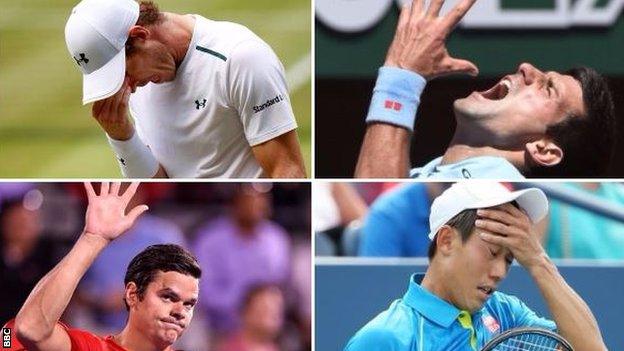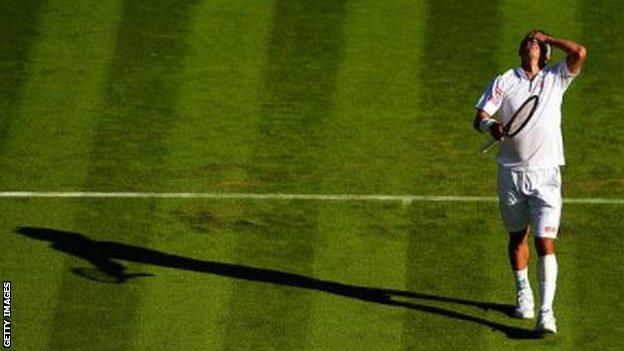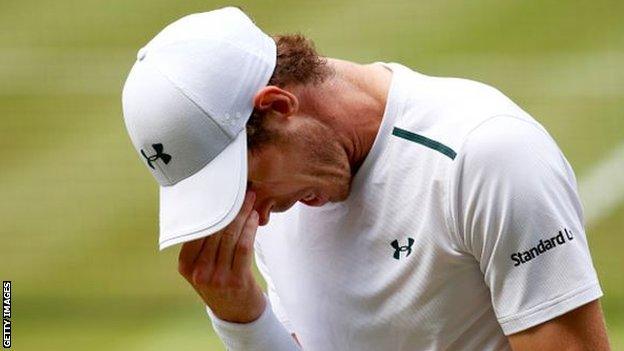US Open: Andy Murray, Novak Djokovic & Milos Raonic among those missing
- Published
- comments

Andy Murray, Novak Djokovic, Milos Raonic and Kei Nishikori will not feature in this year's US Open
US Open |
|---|
Venue: Flushing Meadows, New York. Dates: 28 August - 10 September |
BBC coverage: Commentary on BBC Radio 5 live and Radio 5 live sports extra, plus live text commentary on the BBC Sport website. |
His words competing with rapidly firing camera shutters, an emotional Andy Murray announced his withdrawal from the year's final Grand Slam.
A final practice session with Lucas Pouille meant he had no choice but to end his US Open hopes.
The hip he injured in the French Open semi-final, and which so hindered him at Wimbledon, proved too sore to allow him to compete in the tournament.
And so the five most successful men of 2016 will be absent in New York.
Emotional Murray withdraws from US Open
Novak Djokovic's season is over because of an elbow injury he attributes to "excessive playing".
Stan Wawrinka will also miss the rest of the year following surgery on his knee.
Kei Nishikori won't be seen before January, either, as he has torn a tendon in his right wrist.
And Milos Raonic's post-US Open plans are very uncertain: he has had a procedure to remove fragments of bone which were causing discomfort in one of his wrists.
As Murray flies home to contemplate whether he requires surgery, the ATP Tour points to statistics which show there have been fewer injuries this year than last.
But, given any sport relies heavily on its brightest stars, is now the time to make significant changes to schedules, surfaces and equipment?
Injuries falling on the men's tour?

Kei Nishikori, who was ranked fourth in the world in March, has struggled with wrist problems for several months
The ATP has been studying and tracking injuries since 2012 and, according to its own data, there has been a 7% fall in injuries so far this year.
"Our players are doing a lot of preventative work which is also expanding the number of years they are on the Tour," said Todd Ellenbecker, a former physio who is now the ATP's vice-president of medical services.
"Right now between 40 and 43 players of our top 100 are over 30 years of age," he added.
There is no doubt careers are getting longer, but it also appears as if the burden of the four Grand Slams, the eight mandatory Masters 1000 events and at least four other tournaments the top 30 are routinely required to play is causing problems for that very select group which regularly contests semi-finals and finals.
Last year, Murray played 87 matches, Nishikori 79 and Djokovic 74, but by means of comparison John McEnroe (albeit in a less physically demanding era) played 85 when he recorded the best winning percentage in ATP history in 1984.
Ellenbecker added: "It's probably not the number of matches or tournaments somebody plays - but more the number of sets, the amount of time they are on court and how often they play matches back to back without rest and recovery weeks."
"If somebody has had a history of back problems, hip problems, shoulder problems, they have to do an amazing amount of maintenance work between tournaments just to keep those areas healthy."
Should the schedule be trimmed?

US Open champion Stan Wawrinka will not defend his title in New York because of a knee injury
But rest and recovery weeks are not always available for the maintenance work to take place.
The Masters events in Indian Wells and Miami are played back to back, and so too are the tournaments in Madrid and Rome in May, and in Canada and Cincinnati in August.
If you are among the top eight players of the year, this season will conclude with the ATP Finals in the third week of November. Next season will begin on New Year's Day.
This allows just six weeks - or five for players involved in the Davis Cup final - to rest, recover and fit in a two to three-week training block.
The ATP Tour calendar is under review, with any changes to take effect in 2019, but the season is very likely to remain the same length with the major events keeping their current place in the calendar.
Commercial factors weigh heavily, but it also tends to suit players who are away from home to move from, say, one American event to another without too much downtime in between.
There may possibly be a move towards more longer ATP events - in a similar vein to the 12-day tournaments in Indian Wells and Miami. This would allow players more rest days during events, but the schedule will remain long and crowded, which is of course very much in the interests of those majority Tour members who rarely progress past the first couple of rounds.
Should Murray and Djokovic take more personal responsibility?
Djokovic says decision not to play for rest of 2017 was 'not easy'
Djokovic has played an average of 82 matches in each of the past 10 years, almost exactly the same as Roger Federer did at a comparable stage of his career. Given his extraordinary and sustained success, it is hard to argue he should have played less, even if there is now a price to pay.
Murray played 70 matches from May to November of last year, but look what he achieved in winning Wimbledon, the Olympics and becoming world number one. Two Davis Cup ties and the Olympic Games added to his workload yet he only just fulfilled his required commitment to the ATP Tour. He was arguably too successful for his own good.
From January, however, Murray will have total freedom in designing his own schedule.
By then, he will have played more than 600 matches, completed 12 years of service and celebrated the New Year as a 30-something for the first time: players who have fulfilled all three criteria have complete exemption from the Tour's player commitment rules.
A week off means no ranking points, which in turn might affect seeding for the major tournaments, but the ball will at least be in Murray's court.
Balls and surfaces

Andy Murray announced his withdrawal from this year's US Open on Saturday
Hard courts are the most taxing on the body, but they remain the sport's predominant surface and there is unlikely to be any reduction in the number of hard-court events staged.
If anything, given some promoters' preference for hard courts, the ATP has more of a battle to sustain the current number of clay-court tournaments.
Should anything be done about the regular switch in the make of balls? Rafael Nadal thinks so.
The Dunlop ball, for example, is used for the ATP's clay-court Masters events in the spring, and then a Babolat ball at the French Open. And while a Penn ball is used for the North American hard-court tournaments in August, a Wilson ball is then introduced at the US Open. Some balls are heavier than others.
"It is very bad decision to play Toronto and Cincinnati with one kind of ball and play here with a different kind of ball," Nadal said on the eve of this US Open.
"That's very bad for the wrist, for the elbow, for the shoulder. That's bad, seriously. There is contracts and I understand, but there is some ways that you can fix it, no?"
US Open 2017 - A taste of the future?
Archive: Andy Murray limps out of Wimbledon
The rules of engagement are likely to remain very similar, therefore, come 2019. The ATP Tour is doing very well commercially and many players are broadly happy - including 19-time Grand Slam champion Federer, who ascribes the current spate of injuries to the age of the elite.
"I believe it's mostly because they are 30-plus. Wear and tear just takes its toll. Maybe some players have just had enough of playing hurt and told themselves: 'When I come back I just want to be 100%.'
"I don't think there needs to be that much addressing, because players have the option not to play as much as sometimes they have to or want to. I don't think the tour is doing much wrong, to be quite honest."
But, in the absence of so many stars, this US Open could be a real test of the pulling power of the supporting cast. Federer and Nadal are in the same half of the draw, and so will play on the same day, leaving Alex Zverev and Marin Cilic as the only top-10 players who could feature on the other day.
There is very little stardust in that half of the draw, so it would be an ideal time for the next generation to strut their stuff.
Denis Shapovalov, Borna Coric, Karen Khachanov and Thanasi Kokkinakis are just four with the chance to shine.